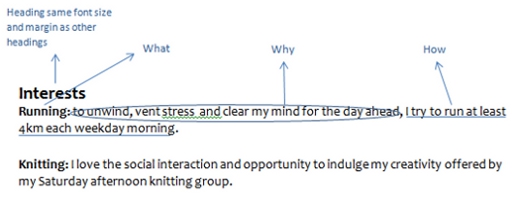In this section, you need to give the employer a more rounded view of who you are as a person.
How you spend your spare time matters
Believe it or not, what you do in your spare time tells an employer quite a lot about what sort of person you are, and how you'll fit in with their team. Employers look for a lot of information in this section, such as:
- how you manage stress
- how you balance your work life with your home life
- whether you're adventurous, creative, intellectual, precise, or laid-back
- whether you're social or private
- whether you're community focused or self-focused
- how your personality might gel with those of existing employees and the existing group dynamic
So think about what message you're putting across when you draft this section and bear in mind how your prospective employer will approach it.
Pick your top 5 interests
Have a look at the list of interests you put together at the 'Organise' stage. You need to compress it down to 4 or 5 main interests - for this section, pick the ones which are the most important to your life. They are the ones that will paint the most accurate and helpful portrait of you.
Write a 'What, Why, How' sentence for each
For each interest, write one sentence describing the interest and what part it plays in your life, bearing in mind the information the employer is looking for here. For example, you may be a runner:
Running: to unwind, vent stress and clear my mind for the day ahead, I try to run at least 4km each weekday morning.

Keep your language formal, but friendly and personal.
Make the key information accessible to the reader
The key to an effective layout in your interests section is to make the key information really accessible - describe the interest in one word at the start of the line, make it bold, then put a colon (:) and go on to your description.
As a rule of thumb, each description should be structured in the same way. The description above, for example, is structured What, Why, How.
Structure and present your skills to take advantage of the reader's needs and habits
- The What, Why, How structure presents the information in order of importance to the employer - they want to know what you're interested in, then why (or what it adds to your life), then how you integrate it into your life
- Keeping the structure the same each time will help ensure that the reader picks up all the information they need without having to work for it
- Putting the short, one word description of the skill on the left and in bold will ensure that the reader will pick up the basic information when they skim read your application
Nearly there! Next, put your Referees section in place.
Previous – Step 7: Present your work history
Next – Step 9: List your referees